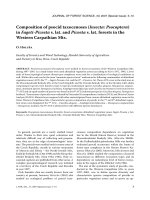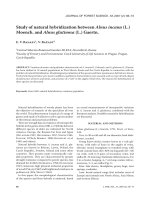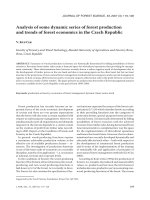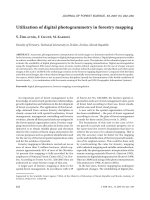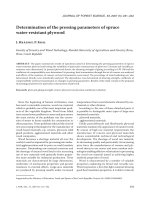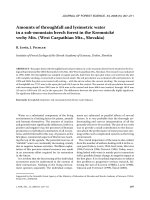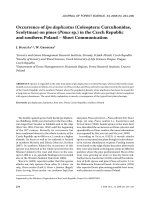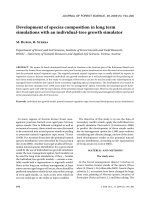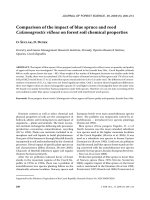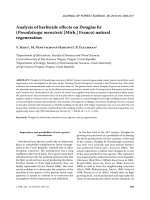Báo cáo lâm nghiệp: "Effect of gibberellic acid and ethephon on the germination of European beech dormant and chilled beechnuts" pptx
Bạn đang xem bản rút gọn của tài liệu. Xem và tải ngay bản đầy đủ của tài liệu tại đây (360.78 KB, 8 trang )
J. FOR. SCI., 56, 2010 (9): 389–396 389
JOURNAL OF FOREST SCIENCE, 56, 2010 (9): 389–396
Supported by the Ministry of Agriculture of the Czech Republic, Projects No. QD0173, and No. MZE 0002070203.
Effect of gibberellic acid and ethephon on the germination
of European beech dormant and chilled beechnuts
P. K, L. B, Z. P
Forestry and Game Management Research Institute, Strnady, Kunovice Research Station,
Kunovice, Czech Republic
ABSTRACT: The effect of ethephon (80, 100 and 120 mg·l
–1
) and gibberellic acid (GA
3
) (40, 300 and 1,000 mg·l
–1
) on
the germination capacity (GC) and mean germination time (MGT) of European beech (Fagus sylvatica [L.]) dormant
beechnuts or beechnuts pre-chilled for four weeks was determined. Compared to the control (dormant untreated seeds)
or beechnuts treated with tap water no significant increase in mean GC was detected after the application of ethephon
or GA
3
to dormant seeds. Conversely, both ethephon and GA
3
treatments reduced (ethephon significantly) GC when
applied to beechnuts chilled for four weeks prior to treatment. The effect of the treatments on germination speed (MGT)
and dormancy release significantly improved when beechnuts were chilled for four weeks prior to the application of
ethephon or GA
3
. However, the effect of GA
3
on MGT of chilled beechnuts was not so distinct compared to dormant
untreated seeds. Reduction in MGT was most obvious in seeds hydrated with 1,000 mg·l
–1
GA
3
prior to germination.
Their cold requirement time was reduced by three weeks compared to beechnuts hydrated in tap water.
Keywords: ethephon; Fagus sylvatica; germination; gibberellic acid
European beech (Fagus sylvatica [L.]) is one of
the most widely-grown, deciduous forest trees in
Czech forests. It takes up 7.0% (182 thousand ha)
of the total Czech forest land and this area is slowly
increasing. Although natural beech regeneration is
successful, artificial reforestation is still needed. In
2008 beech was planted on 3 865 ha, which repre-
sents 19% of the reforested area in that year (Report
on the state of forests and forestry in the Czech Re-
public in 2008). As such, it is necessary to ensure
that sufficient beechnuts are available for nursery
sowing and increased seedling production.
Beechnuts, seeds of European beech, are deeply
dormant orthodox seeds. Beechnut lots vary dra-
matically in dormancy which is released by moist
chilling of beechnuts to 28–30% moisture content
(mc) for 4–12 weeks, sometimes 20 weeks (G-
1991; S et al. 1994; P et
al. 2002). is long chilling can drastically decrease
germination or even result in a complete loss of
germination in less vigorous seedlots. Faster dor-
mancy release should result in reducing the chilling
period, improve germination and increase seedling
stands in nurseries.
e effect of low temperature on dormancy re-
lease of seeds of various tree species can be re-
placed by applying chemicals such as gibberel-
lic acid or ethylene. ese chemicals stimulate
the germination of non-dormant seeds (B,
B 1982; P, Š 1997; B,
B 2001). Ethylene (ethene) is a colourless gas
produced by plants and microorganisms, including
fungi (G 1998). It can be applied to plants
in a solid, water-soluble form – ethephon (acid
2-chlorethylphosphate). In plant tissues, ethephon
degrades to ethylene, chlorides and phosphates
(P, Š 1997).
e physiological effects of ethylene are highly
variable. e most common effect is slowing down
the elongation of stems and roots with simultaneous
thickening while other effects include loss of geot-
ropism, production of adventitious roots, shedding
of leaves, flowers and fruits, and stimulation of fruit
maturation and seed germination (G 1998).
390 J. FOR. SCI., 56, 2010 (9): 389–396
e molecular mechanism of ethylene impact on
dormancy release is not well known (C
et al. 1994; C, C 1995 ex B-
et al. 2002). E and S (1982 ex
P, Š 1997) assumed that ethyl-
ene increases the production of xylanase forming
channels through the walls of the aleuron cells of
seed, supporting the release of α-amylase, an en-
zyme that stimulates germination by degrading
starch. ough ethylene overcomes dormancy and
increases seed germination of many species (B-
, B 1982; B, B 2001), other
seeds are unaffected or their germination is even
inhibited (B, B 2001). e effective
ethylene concentration that stimulates germina-
tion is 0.1–200 l·l
–1
(B, B 1982), i.e.
0.1–200 cm
3
·m
–3
.
Gibberellic acid (GA
3
)
is one of the most frequent-
ly used gibberellins (H 2005). Gibberellins
accumulate in developing embryos and by the time
of seed maturation they exist in a fixed form. After
seed imbibition, gibberellins are released and the
embryo starts synthesizing gibberellins de novo. In
barley grain, where this process has been studied
in detail, free gibberellins were found to be trans-
ported to the aleuron layer of the seed, where they
induced the production of α-amylase and subse-
quently hydrolytic enzymes (J, J
1991 ex P, Š 1997).
Hydrolytic enzymes then move to the endosperm,
where they degrade reserve sugars and proteins, and
provide enough energy and building materials for
the growing embryos. e induction of α-amylase
is very effectively inhibited by abscise acid (ABA).
Inhibitors such as ABA gradually degrade and the
gibberellin level increases during cold stratifica-
tion. By exogenous application of gibberellins it is
possible to intensify the effect of cold stratification,
thus the stratification of seeds is partly replaced
with gibberellins (P, Š 1997).
is procedure works especially well in species
with weak or medium-deep seed physiological dor-
mancy, but less so in seeds with deep physiologi-
cal dormancy (N et al. 1973; N
1977 ex B, B 2001). Better effects can
be obtained in such seeds by gentle scarification
or puncturing or scratching the seed coats (B-
, B 1982). However, the application of gib-
berellins can be lethal for seeds of some species or
can induce significant elongation and etiolation of
the seedlings or cause seedling mortality. e le-
thal concentration of GA
3
for seeds of some spe-
cies is 1,000 ppm, while 500 ppm has no effect and
the 750 ppm concentration has a positive influence
(H 2005). According to B and B
(1982) the effective concentrations of gibberellins
for releasing seed dormancy are 10
–5
to 10
–3
M.
e purpose of the present paper was to deter-
mine the effect of gibberellic acid and ethephon on
overcoming beechnut dormancy and stimulation
of beechnut germination.
MATERIALS AND METHODS
Seeds
ree beechnut seedlots with a moisture con-
tent of 8.6–9.0% and stored in sealed plastic bags at
–7°C for two to four years at the Tree Seed Centre
in Tyniste n. Orlici were used in our experiments.
e beechnuts originated from two natural for-
est regions and two altitudinal zones (Table 1). In
the laboratory the beechnuts were kept in sealed
Table 1. Beechnut (Fagus sylvatica) seedlots and their initial quality before applying ethephon (May 2005) or
GA
3
(October 2005)
Seedlot
No.
Year of
ripening
Natural forest
region,
Czech Republic
Altitude zone
(m a.s.l.)
Viability (%)*
1,000 seed
weight (g)**
Moisture
content (%)***
May 2005 October 2005
229 2001
Stredomoravske
Karpaty (36)
400–550 58 64 241.4 9.0
241 2003
Luzicka piskovcova
vrchovina (19)
600–700 66 66 277.4 8.6
243 2003
Luzicka piskovcova
vrchovina (19)
400–550 77 71 267.8 9.0
*Based on four replicates of 100 seeds each; **Based on two replicates of 10 g of seeds each; ***Based on eight replicates of
100 seeds each
J. FOR. SCI., 56, 2010 (9): 389–396 391
plastic bags at –5°C until used. e initial viabil-
ity of the beechnuts varied from 58 to 77% and the
1,000 seed weight from 241.4 to 277.4 g (Table 1).
Treatments (control, application of ethephon,
GA
3
or tap water)
Ethephon (2-chlorethylphosphonic acid, C
2
H
6
Cl-
O
3
P) or gibberellic acid (GA
3
, C
19
H
22
O
6
) were ap-
plied either to dormant beechnuts (8–9% mc, here-
after “9%”) or beechnuts (28–30% mc, hereafter
“30%”) chilled for 4 weeks (Table 2). Each treat-
ment consisted of eight replications of 50 seeds per
seedlot.
In treatment 1 (control) seeds with 9% mc were in-
corporated (without previous soaking) into a moist
peat-sand substrate (28–30% mc) and incubated in
a closed plastic boxes at 4±1°C (hereafter “4°C”) in
the dark (see germination determination).
In treatments 2 to 5 the moisture content of dor-
mant beechnuts (9%) was slowly increased to a tar-
get 30% mc by sprinkling the beechnuts with tap
water, ethephon (80, 100 and 120 mg·l
–1
) or GA
3
(40, 300 and 1,000 mg·l
–1
) for five to seven days. Tap
water, ethephon or GA
3
were used to reach the tar-
get mc of the beechnuts. en the beechnuts were
mixed with the moist peat-sand substrate and incu-
bated as described above (control).
In treatments 6 to 9 the mc of beechnuts was in-
creased by sprinkling them with tap water to ob-
tain the target mc (30%). en the beechnuts were
chilled (without medium) at 4°C in the dark and
after four weeks chilling they were imbibed either
with tap water, ethephon (80, 100 and 120 mg·l
–1
)
or GA
3
(40, 300 and 1,000 mg·l
–1
) for 20 hours. e
imbibition resulted in 31–35% mc of beechnuts.
en the beechnuts were mixed with the moist
peat-sand substrate and incubated as described
above.
Moisture content, 1,000 seed weight,
viability, germination capacity and mean
germination time
e moisture content (fresh weight basis) was
determined on two replications of cut beech-
nuts (10 g each) dried at 103 ± 2°C for 1 hour in a
Brabender apparatus (Brabender OHG, Duisburg,
Germany) (CSN 48 1211 1997). e thousand seed
weight (8 × 100 seeds) and viability (tetrazolium test)
(4 × 100) were determined according the ISTA
Rules (2005).
Germination tests were done using a peat-sand
substrate (1:1 by volume) (CSN 48 1211 2006) with
400 seeds of each seedlot being mixed with a peat-
sand substrate (one volume of seed to two vol-
umes of substrate, 28–30% mc) for germination in
17 × 12 cm boxes at 4°C in the dark. e boxes were
fitted with translucent lids and were opened weekly
to check the germinants. Beechnuts with 5–10 mm
long radicles were considered as germinated and
discarded after counting. Germination counts were
done weekly from the first week after sowing until
when no germinants were observed in two consec-
Table 2. Treatments applied to the beechnuts. In treatments 1–5 dormant beechnuts were hydrated by sprin-
kling them with tap water, ethephon or GA
3
for 5 to 7 days before mixing them into the germination substrate.
In treatments 6–9 dormant beechnuts were hydrated by sprinkling them with tap water to increase their moisture
content to 30%, where upon they were chilled (without substrate) at 4°C for 4 weeks, then soaked for 20 h in tap water,
ethephon or GA
3
before mixing them into the germination substrate
Treatments Material Tap water Ethephon (mg·l
–1
) GA
3
(mg·l
–1
)
1 (control)
dormant seeds
(9.0% mc)
no – –
2 80 40
3 100 300
4 120 1,000
5 yes – –
6
seeds chilled for
4 weeks (30% mc)
80 40
7 100 300
8 120 1,000
9 yes – –
392 J. FOR. SCI., 56, 2010 (9): 389–396
utive weeks. en, all the remaining (non-germi-
nated) seeds were cut and the dead (rotten), empty
and ‘fresh’ seeds were counted. e fresh seeds (if
any) were included in germinated seeds. e germi-
nation tests terminated after ca five months when
germination ceased. Germination capacity (GC)
and MGT were calculated as the mean of eight rep-
lications plus or minus the standard error.
Mean germination time (MGT) was used to
determine the speed of germination. It was cal-
culated according to the modified formula:
MGT = ∑(n
i
× t
i
) × n
–1
total
where n
i
is the number
of seeds germinated in a specific week (t) and n
total
is the total number of germinated seeds (Y-
, S 1985 ex F et al. 1997).
Data analyses
Seedlot and treatment effects, and their interac-
tions, were determined by two-way ANOVA and
the significance of mean differences was deter-
mined using the Scheffe’s test (StatSoft Inc. 2005).
Table 3. Analysis of variance results showing the effects of pre-stratification treatments with ethephon and GA
3
on
beechnuts (Fagus sylvatica) on their germination capacity (GC) and mean germination time (MGT)
Effect df
GC MGT
SS MS F P SS MS F P
Treatment (ethephon) 8 8,626.1 1,078.3 14.9 0.000 270.7 33.8 90.8 0.000
Seedlots 2 23,464.0 11,732.0 161.5 0.000 315.8 157.9 423.6 0.000
Treatment × Seedlot 16 2,702.5 168.9 2.3 0.003 24.5 1.5 4.1 0.000
Treatment (GA
3
) 8 4,294.7 536.8 7.0 0.000 696.8 87.1 384.9 0.000
Seedlots 2 21,758.9 10,879.5 141.5 0.000 219.6 109.8 485.3 0.000
Treatment*Seedlot 16 2,401.1 150.1 2.0 0.018 33.3 2.1 9.2 0.000
df – degrees of freedom, SS – sum of squares, MS – mean squares, F – F-distribution, P – probability
Table 4. Germination capacity (GC) and mean germination time (MGT) of dormant or chilled beechnuts (Fagus
sylvatica) treated with tap water, ethephon or GA
3
Treatments
Ethephon GA
3
GC (%) MGT (weeks) GC (%) MGT (weeks)
Dormant seeds
(9.0% mc)
control (no soaking) 69.3
b
13.0
d
61.7
ab
14.3
g
80 mg·l
–1
ethephon or
40 mg·l
–1
GA
3
68.2
b
12.1
ac
65.3
b
9.5
de
100 mg·l
–1
ethephon
or 300 mg·l
–1
GA
3
72.3
b
12.0
ac
64.3
b
8.7
abc
120 mg·l
–1
ethephon
or 1,000 mg·l
–1
GA
3
62.5
ab
12.5
ad
63.5
ab
8.2
a
tap water 66.3
bc
12.6
ad
57.6
ab
11.4
f
Seeds chilled for
4 weeks (30% mc)
80 mg·l
–1
ethephon or
40 mg·l
–1
GA
3
57.4
ac
10.0
b
55.4
ab
9.2
cd
100 mg·l
–1
ethephon
or 300 mg·l
–1
GA
3
54.8
a
10.1
b
55.3
ab
9.0
bc
120 mg·l
–1
ethephon
or 1,000 mg·l
–1
GA
3
55.1
a
10.0
b
53.9
a
8.7
ab
tap water 57.6
ac
11.7
c
53.6
a
9.8
e
Data are the means of eight replicates of 50 seeds each. Values in the same column followed by the same letter are not
significantly different (Scheffe test, α = 0.05).
J. FOR. SCI., 56, 2010 (9): 389–396 393
RESULTS
e ANOVA detected a significant effect (α = 0.05)
of seedlots and ethephon or GA
3
treatments on
germination capacity and MGT. e two-way in-
teraction (seedlot × treatment) effect on germina-
tion was significant only for ethephon but not for
GA
3
while a highly significant interaction effect on
MGT was detected (Table 3).
Compared to control (dormant non-soaked)
seeds or beechnuts treated with tap water no sig-
nificant increase in mean germination capac-
ity was detected after applying ethephon or GA
3
to dormant seeds. Conversely, the ethephon and
GA
3
treatments reduced (ethephon significantly)
germination capacity when applied to beechnuts
chilled for four weeks prior to treatment (Table 4;
Figs. 1 and 2).
e highest, but insignificant, mean germination
capacity (72.3%) occurred when dormant beech-
nuts were imbibed in 100 mg·l
–1
of ethephon and
then chilled (Table 4).
e effect of the treatments on germination
speed (MGT) and dormancy release significantly
improved when beechnuts were chilled for four
weeks prior to applying ethephon or GA
3
(Fig. 2).
However, the effect of GA
3
on MGT of chilled
beechnuts was not so distinct compared to dor-
mant seeds (Fig. 2b).
DISCUSSION
Our results show that neither ethephon (80, 100
or 120 mg·l
–1
) nor GA
3
(40, 300 or 1,000 mg·l
–1
) in-
creases the germination capacity of beechnuts. is
contradicts the results of F et al. (1997),
who also increased the mc of dormant beechnuts to
30% by soaking them in GA
3
(100 or 300 mg·l
–1
) or
ethephon (100 mg·l
–1
) or tap water. After 3 weeks
(b)
Fig. 1. Germination capacity of beechnuts (Fagus sylvatica)
treated with ethephon (a) or GA
3
(b)
1 – control, 2 – dormant seeds treated with 80 mg·l
–1
of ethephon or 40 mg·l
–1
of GA
3
, 3 – dormant seeds
treated with 100 mg·l
–1
of ethephon or 300 mg·l
–1
of GA
3
,
4 – dormant seeds treated with 120 mg·l
–1
of ethephon or
1,000 mg·l
–1
of GA
3
, 5 – dormant seeds treated with tap water,
6 – seeds chilled for 4 weeks and then treated with 80 mg·l
–1
of ethephon or 40 mg·l
–1
of G
A3
, 7 – seeds chilled for
4 weeks and then treated with 100 mg·l
–1
of ethephon or
300 mg·l
–1
of GA
3
, 8 – seeds chilled for 4 weeks and then
treated with 120 mg·l
–1
of ethephon or 1,000 mg·l
–1
of GA
3
,
9 – seeds chilled for 4 weeks and then treated with tap water.
Vertical bars show means and SE
Germination capacity (%)
Treatments
(a)
Germination capacity (%)
Treatments
394 J. FOR. SCI., 56, 2010 (9): 389–396
of chilling beechnuts treated with GA
3
or ethephon
germinated ca 20% better than beechnuts imbibed
with tap water. Even prolonging the chilling period
for tap water treated beechnuts did not increase
germination. Clearly chilling duration was suffi-
cient to break dormancy and the effect of GA
3
and
ethephon only stimulated the germination of less
vigorous beechnuts.
Similarly, GA
3
(200 mg·l
–1
) improves the germi-
nation of stored beechnuts by 15–18% compared
to control beechnuts (M, B-M-
1983; M 1983 ex S 1990). In ear-
lier experiments F, W (1966 ex
S 1990) found that the application of gibber-
ellic acids was effective only for beechnuts where
the pericarp had been removed, while seeds with
the intact pericarp were not affected.
M and E (2004) also observed
a positive effect of gibberellic acid only on one of
two seedlots, while the treatment of dormant seeds
with GA
3
(35 mg·l
–1
) resulted in no change in ger-
mination capacity compared to beechnuts chilled
for six weeks. However, the germination capacity
of 10-week chilled beechnuts was the same (over
90%) as for seeds treated with GA
3
.
us, GA
3
only
reduced dormancy release without rise in germina-
tion. ey observed the same effect for ethephon
(144 mg·l
–1
), which reduced the chilling require-
ment by about three weeks without any increase in
germination capacity.
In our experiments the ethephon treatment was
similar to that of F et al. (1997) and M-
and L (2003). Dormant beechnuts with
the intact pericarp were hydrated in ethephon
(100 g
·l
– 1
) or tap water (control) to reach 30% mc
and then chilled for various periods. After seven
weeks of chilling, beechnuts imbibed in ethephon
reached 83% germination, while only 74% of seeds
treated in water (control) germinated and the lon-
ger chilling did not increase germination capacity
Fig. 2. Mean germination time of beechnuts (Fagus syl-
vatica) treated with ethephon (a) or GA
3
(b)
1 – control, 2 – dormant seeds treated with 80 mg·l
–1
of ethephon or 40 mg·l
–1
of GA
3
, 3 – dormant seeds
treated with 100 mg·l
–1
of ethephon or 300 mg·l
–1
of GA
3
,
4 – dormant seeds treated with 120 mg·l
–1
of ethephon or
1,000 mg·l
–1
of GA
3
, 5 – dormant seeds treated with tap water,
6 – seeds chilled for 4 weeks and then treated with 80 mg·l
–1
of ethephon or 40 mg·l
–1
of GA
3
, 7 – seeds chilled for
4 weeks and then treated with 100 mg·l
–1
of ethephon or
300 mg·l
–1
of GA
3
, 8 – seeds chilled for 4 weeks and then
treated with 120 mg·l
–1
of ethephon or 1,000 mg·l
–1
of GA
3
,
9 – seeds chilled for 4 weeks and then treated with tap water.
Vertical bars show means and SE
Treatments
(b)
MGT (weeks)
(a)
MGT (weeks)
Treatments
J. FOR. SCI., 56, 2010 (9): 389–396 395
either (F et al. 1997). M and L
(2003) also found that germination capacity and
emergence of stored beechnuts treated with ethe-
phon after three weeks of subsequent chilling were
nearly the same (74%) as in the control (71%).
It is evident that the treatment of beechnuts with
gibberellic acid or ethephon only results in a slight
increase in the germination capacity of some, less
vigorous seedlots. More frequently the application
of these two chemicals speeds up dormancy release
without affecting germination capacity. Our results
showed similar germination capacity of beechnuts
treated with these chemicals compared to untreated
seeds. However, the germination rate (MGT) after
ethephon and GA
3
application increased compared
to control beechnuts.
In our studies higher germination occurred in
dormant, not chilled beechnuts hydrated to 30% mc
prior to the germination test while soaking seeds in
tap water or ethephon or GA
3
after 4-weeks chill-
ing resulted in lower germination (Table 4). us,
short chilling prior to applying ethephon or GA
3
did not improve the germination capacity, but in-
stead beechnut germination was poorer. e rea-
son might be the mixing of chilled beechnuts with
higher mc (31 to 35%) with peat-sand substrate of
ca 30% mc. e optimum mc of beechnuts for dor-
mancy release reported by S et al. (1994) was
30–32% while H (1999) or M et
al. (1999) did not recommend mc above 30% due to
the increasing risk of moulding.
Our germination test of beechnuts was done at
the same temperature (3–5°C) as the pre-sowing
(dormancy release) treatment. While according to
the ISTA Rules (ISTA 2010) the germination test
must be carried out on top of the germination pa-
per, S et al. (1994) recommended the mix-
ing of beechnuts with moist substrate. However, no
recommendation has been made regarding the pre-
cise mc of beechnuts prior to the germination test.
We have found that beechnuts germinated faster
when their mc was increased to 28% at least before
germinating them. e MGT of beechnuts hydrat-
ed with tap water was slightly reduced as compared
to control (no soaking) beechnuts, but GA
3
signifi-
cantly speeded up germination compared to beech-
nuts which were allowed to gradually absorb water
from the germination substrate (Table 4; Fig. 2).
We found no apparent effect of different concen-
trations of ethephon or GA
3
on germination ca-
pacity. e only exception was the application of
1,000 mg·l
–1
GA
3
to dormant seeds that reduced
the MGT to six weeks compared to the control
(Table 4). In previous studies, the application of
rather low concentrations of GA
3
affected the ger-
mination rate (MGT), e.g. 200 mg·l
–1
on intact
beechnuts or 35 mg·l
–1
on beechnuts without peri-
carp (B-M and M 1976 ex
S 1990; N et al. 1996; M
and E 2004). F et al. (1997) found
no difference in the germination of pre-chilled, in-
tact beechnuts treated either with 100 or 300 mg·l
–1
GA
3
while dormant seeds germinated better when
treated with 300 or 1,000 mg·l
–1
GA
3
compared to
10-100 mg·l
–1
GA
3
. Evidently, a lower dose of GA
3
did not compensate for pre-chilling. In the case of
ethephon the recommended concentrations are
100 mg·l
–1
(F et al. 1997; F et al.
1997; M and L 2003) or 144 mg·l
–1
(M and E 2004). e effect of
higher concentrations of ethephon on beechnut
germination is not known.
Acknowledgements
We thank both reviewers for valuable comments.
R e fe re nces
B C.C., B J.M. (2001): Seeds. Ecology, Biogeog-
raphy, and Evolution of Dormancy and Germination. San
Diego, Academic Press: 666.
B J.D., B M. (1982): Physiology and Biochemistry
of Seeds in Relation to Germination. 2. Viability, Dormancy
and Environmental Control. Berlin, Springer-Verlag.
B F., N F.N., S C.M. (2002): Possible
involvement of proteasome activity in ethylene-induced
germination of dormant sunflower embryos. Brazilian
Journal of Plant physiology. Available at elo.
br/scielo.php?pid=S167704202002000200007&script=sci_
arttext&ttling=en (accessed January 14, 2005).
CSN 48 1211 (1997): Czech Technical Rules. Collection,
quality and methods for testing forest tree seeds. Prague,
CNI: 56. (in Czech)
CSN 48 1211 (2006): Czech Technical Rules. Forest manage-
ment – Collection, quality and methods for testing forest
tree seeds. Prague, CNI: 56. (in Czech)
F E., M C., L E. (1997): Effect of ethep-
hon on dormancy breaking in beechnuts. In: E R.H.,
B M., M A.J., H T.D. (eds): Basic and
Applied Aspects of Seed Biology. Dordrecht, Kluwer Aca-
demic Publishers: 303–309.
F H., D P., F E., M C., B-
-M M. (1997): Endogenous gibberellins and
dormancy in beechnuts. In: E R.H., B M., M-
A.J., H T.D. (eds): Basic and Applied Aspects
of Seed Biology. Dordrecht, Kluwer Academic Publishers:
311–321.
396 J. FOR. SCI., 56, 2010 (9): 389–396
G J. (1998): Physiology of plants. Available at http://
www.sci.muni.cz/~fyzrost/part_03.pdf (accessed August
4, 2005). (in Czech)
G, P. (1991): Beechnuts storage. A review and practi-
cal interpretation of the scientific literature. Forestry, 64:
51–59.
ISTA (2004): International Rules for Seed Testing. Zurich,
International Seed Testing Association.
H Z. (1999): Technology of storage and pre-treat-
ment of silver fir and European beech in Tree Seed Centre
Tyniste n. Orlici. In: Production of Nursery Stock from
the Long-term Storage of European Beech and Silver Fir
Seeds. Hradec Králové, Česká lesnická společnost: 18–20.
(in Czech)
H J.L. (2005): Gibberellic acid kits and supplies, Gib-
berellic acid-3 information sheet. Available at http://www.
jlhudsonseeds.net/GibberellicAcid.htm (accessed January
25, 2005).
M J., J A., T J. (1999): Handling
with stratified beechnuts and sowing of control samples
in Opočno In: Production of nursery stock from the long-
term storage of European beech and silver fir seeds. Hradec
Králové, Česká lesnická společnost: 21–24. (in Czech)
M L.C., E E.N. (2004): e effect of gib-
berellic acid, paclobutrazol and ethephon on the germina-
tion of Fagus sylvatica and Picea sitchensis seeds exposed
to varying durations of moist chilling. Seed Science and
Technology, 32: 21–33.
M C., L E. (2003): Ethephon (2-chlorethylphos-
phonic acid) combinated with short prechilling improves
germination in stored beechnut. Seed technology, 25:
83–91.
N C., N G., R D. (1996): Antago-
nistic effects of abscisic acid and gibberellic acid on the
breaking of dormancy of Fagus sylvatica seeds. Physiologia
Plantarum, 96: 244–250.
P S., Š J. (1997): Plant Growth Regulators.
Prague, Academia: 395. (in Czech)
P Z., B L., M J., P-
E. (2002): Quality of beechnuts from different crop
years. Dendrobiology, 47: 39–42.
S B., M C., B-M M. (1994):
Seeds of Forest Broadleaves from Harvest to Sowing.
Warszawa-Poznan, Wydawnictwo naukowe PWN: 299.
(in Polish)
S B. (1990): Beech – Fagus sylvatica. Our forest trees.
Poznan, Wydawnictwo naukowe PWN, 10: 375–498. (in
Polish)
StatSoft, Inc. (2005). STATISTICA Cz 7.1. Available at http://
www.statsoft.cz/ (accessed January 25, 2005).
Report on the state of forests and forestry in the Czech Re-
public in 2008. (2009). Prague, MZe: 132.
Recieved for publication March 10, 2010
Accepted after corrections April 28, 2010
Corresponding author:
Ing. L B, Výzkumný ústav lesního hospodářství a myslivosti, Strnady, Výzkumná stanice Kunovice,
Na Záhonech 601, 686 04 Kunovice, Česká republika
tel.: + 420 572 420 919, fax: + 420 572 549 119, e-mail:
